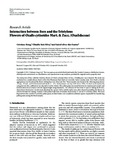Use este identificador para citar ou linkar para este item:
http://www.alice.cnptia.embrapa.br/alice/handle/doc/940345Registro completo de metadados
| Campo DC | Valor | Idioma |
|---|---|---|
| dc.contributor.author | KRUG, C. | pt_BR |
| dc.contributor.author | SILVA, C. I. | pt_BR |
| dc.contributor.author | ALVES-DOS-SANTOS, I. | pt_BR |
| dc.date.accessioned | 2012-11-22T11:11:11Z | pt_BR |
| dc.date.available | 2012-11-22T11:11:11Z | pt_BR |
| dc.date.created | 2012-11-22 | pt_BR |
| dc.date.issued | 2012 | pt_BR |
| dc.identifier.citation | Psyche: A Journal of Entomology, Cambridge, v. 2012, p. 1-8, 2012. | pt_BR |
| dc.identifier.uri | http://www.alice.cnptia.embrapa.br/alice/handle/doc/940345 | pt_BR |
| dc.description | The interaction of bees with the tristylous flowers of Oxalis cytisoides Mart. & Zucc. (Oxalidaceae) was evaluated. The study was conducted in a semideciduous forest at the Fritz Plaumann State Park in Conc ´ ordia, Santa Catarina state. Two Oxalis cytisoides aggregations were found and the flower visiting bees were observed. The 3 floral morphs were found at the following proportions: 16 long-, 37 mid-, and 34 shortstyled individuals (n = 87). Anthesis lasted one day (6:30 AM to 3 PM). No fruit was formed in the autogamy test; thus, pollination was dependent on the visitors. The pollen grain size varied between the stamens and morphs and formed subsets in accordance with the stigma height (long/mid/short).We collected 165 bees from 30 species visiting the flowers. Hypanthium divaricatum was the most abundant bee species (34%) and the males were often observed patrolling the flowers in search of females for mating. Analysis of the pollen loads from 34 females showed that 27 carried O. cytisoides pollen. The most frequent bees that carried O. cytisoides pollen grains on their bodies were considered pollinator agents, responsible for transferring pollen grains among the floral morphs. | pt_BR |
| dc.language.iso | eng | eng |
| dc.rights | openAccess | eng |
| dc.subject | Bees | pt_BR |
| dc.subject | Tristylous flowers | pt_BR |
| dc.subject | Interaction | pt_BR |
| dc.title | Interaction between Bees and the Tristylous Flowers of Oxalis cytisoides Mart. & Zucc. (Oxalidaceae). | pt_BR |
| dc.type | Artigo de periódico | pt_BR |
| dc.date.updated | 2013-02-25T11:11:11Z | pt_BR |
| riaa.ainfo.id | 940345 | pt_BR |
| riaa.ainfo.lastupdate | 2013-02-25 | pt_BR |
| dc.identifier.doi | 10.1155/2012/459683 | pt_BR |
| dc.contributor.institution | CRISTIANE KRUG, CPAA; CLÁUDIA INÊS SILVA, USP/FFCLRP; ISABEL ALVES-DOS-SANTOS, IBUSP. | pt_BR |
| Aparece nas coleções: | Artigo em periódico indexado (CPAA)  | |
Arquivos associados a este item:
| Arquivo | Descrição | Tamanho | Formato | |
|---|---|---|---|---|
| Krugetal2012.pdf | 3.05 MB | Adobe PDF |  Visualizar/Abrir |









